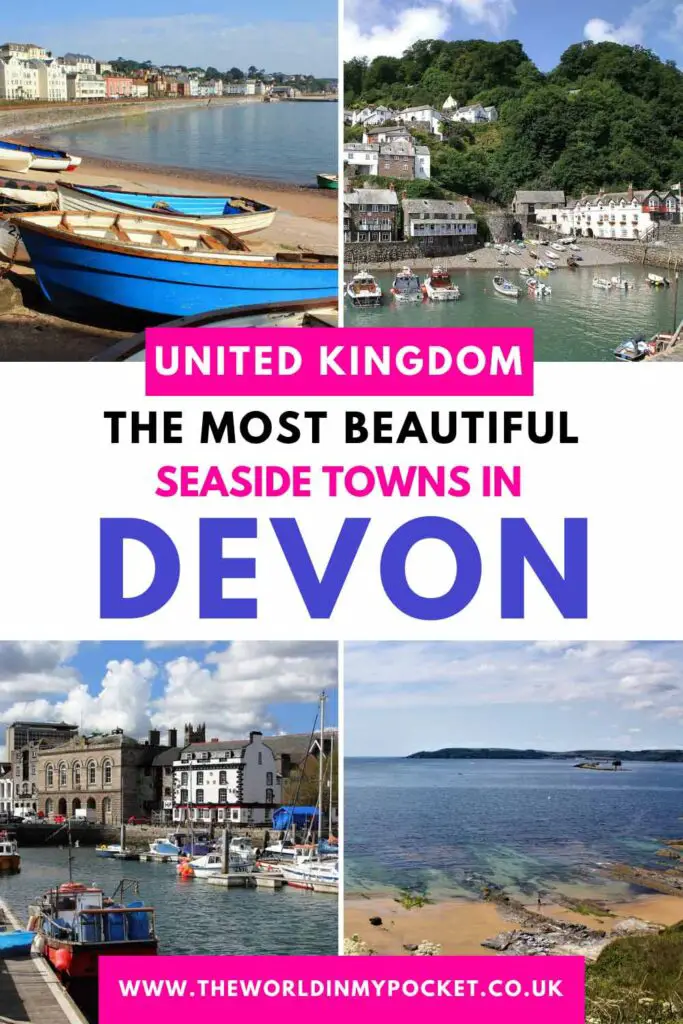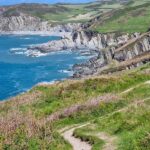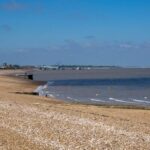Fancy a UK beach break? Devon is a large county in South West England with countless epic sandy bays. People often rush through it on their way to neighbouring Cornwall, but you’re missing a treat if you do; with over 500 miles of coastline, this county has a beach for everyone.
North Devon is punctuated by its rugged cliffs and is known to be sparsely populated, with a smattering of small towns and lots of smaller villages. There are plenty of hotels and campsites, but it’s easier to find secluded natural spots here.
On the other hand, South Devon is the location of Devon’s two cities, Exeter and Plymouth, and its three largest towns – Torquay, Paignton and Exmouth! It’s a lot more built up here, so there are naturally more hotels, more tourist infrastructure and better roads.
However, that doesn’t take away from its beauty – at one end of South Devon you can enjoy the western Jurassic Coast, in the centre there’s an area affectionately known as the English Riviera because of its tropical feel, and towards the west you’ve got the city of Plymouth – Britain’s Ocean City.
There are a lot of seaside towns in Devon, so it’s no surprise if you’re feeling a bit flummoxed as to which one to opt for. To make it easy for you, we’ve put together this guide to all of the best places to enjoy the beach in Devon.
The South Devon Coast

The South Devon Coast is landmarked by Devon’s two cities – Exeter in the east and Plymouth in the West. Exeter isn’t actually a coastal city, but Exmouth is about 12 miles away and is connected to the city by train and bus.
Then, there are the popular holiday towns of Torquay, Paignton, Dartmouth and Salcombe – all beautiful spots with a lot of tourist infrastructure. The coastline isn’t as wild as it is up in North Devon, but the beaches are beautiful, and there are lots of things to do in each town.
How to get to South Devon
You can easily reach Exeter and Plymouth by train or coach from London and Bristol. From these stations, you can connect to other towns in South Devon.
The M5 starts near Exeter and connects to Bristol and Birmingham. From London, you can take the M25, then the M3, then the A303 across the country before joining the M5 at Taunton. From the end of the M5, the A38 runs across the rest of South Devon and into Cornwall. There are still a fair few country roads in South Devon, but a lot less than in the north of the county.
Beer

Photo by Andreas Trepte, www.avi-fauna.info
One thing to note before I tell you about Beer – the village has nothing to do with the alcoholic beverage of the same name. Sorry!
Despite this, it’s well worth visiting. Situated in the Lyme Bay area of the Jurassic Coast, Beer is a shingle beach that is still used by fishers every day – you probably won’t be sunbathing here, but it’s a really interesting place to people watch.
The best attraction in Beer is perhaps the Beer Quarry Caves. These human-made caves were first used for their stone in Roman times but were later a hiding place for contraband that had been smuggled into Devon through the sea. The Southern Devon and Cornish coasts are known for their smuggling history, and this is one of the best places to learn all about it.
The village is beautiful too, with a historic high street with plenty of shops and cafes and a picturesque stream running down the side of the road.
Exmouth

I’m a bit biased (I have family based in Exmouth and have lived there on and off over the years), but I think Exmouth is possibly the Devon beach town that offers the most to tourists.
It’s at the end of the spectacular Jurassic Coast, which is largely considered as one of the most impressive coastal drives in the country. But that’s not all Exmouth offers – it’s also got the beautiful riverside of the Exe Estuary, a prime area for birdwatching and exploring local villages. And inland – hike-able from the town centre – there’s the wild moors.
There are countless things to do in Exmouth, including:
- relaxing on its long beach
- hiking around the cliff tops and to the nearby town of Budleigh Salterton
- stand up paddle boarding at the end of the estuary
- driving inland to villages like the quaint East Budleigh (the birthplace of Sir Walter Raileigh) and Otterton, which is famed for its mill and its river where wild beavers randomly appeared in 2013.
Exmouth town is fairly sizable, and there is a good selection of accommodation options in town, as well as the Haven Devon Cliffs Caravan Park which is just out of town.
Torquay

Torquay is the largest town in the ‘English Riviera’ area of Devon, also known as Torbay. Like the French Riviera, Torquay has plenty of yachts – and there are even some palm trees! This area of Devon is quite touristy, but you’ll still find a few little coves and clifftop views out of the towns.
There are also loads of attractions in Torquay and the nearby smaller town of Babbacombe. First, enjoy the beaches, which offer lots of watersports like jet-skiing, kayaking and stand up paddleboarding (the sea here is a lot more protected than the north coast, so surfing is uncommon although possible on particularly wavy days).
Other than the beaches, there’s Kents Cavern Prehistoric Caves, a complex cave network close to the town. Also, you can visit Torre Abbey, a Medieval monastery turned art gallery just south of the town.
In nearby Babbacombe, there’s the Babbacombe Model Village and the Babbacombe Cliff Railway, both of which are excellent for kids. Or you can visit Bygones, an interesting British history museum featuring a Victorian shopping street.
Paignton

Paignton is right next to Torquay, but it’s another sizable town in its own right and an alternative place to stay in Torbay. It’s most famous for the 240 metre long Paignton Pier, which has lots of amusements and food stalls. There are also quite a few lovely beaches around Paignton, including the beautiful Broadsands Beach.
Dartmouth

Dartmouth is a charming town in the South Devon Area of Outstanding Natural Beauty. There are plenty of delightful beaches in and around the town, and Dartmoor is very easy to get to.
One of Dartmouth’s best attractions is its castle. This castle was built to guard the Dart estuary, and 600 years later, it is still one of the most scenic castles in the country. If you visit the castle, you’ll be able to enjoy these epic views as well as its long-spanning history and learn how it has been instrumental to the town throughout the decades.
You can also take a ferry up the river to Totnes. This ferry is incredibly scenic, and Totnes is a lovely town, with another historic castle and a charismatic old street.
Salcombe

Salcombe is, without a doubt, one of the most gorgeous towns in the county. It is not too far from Plymouth and sits on the Kingsbridge Estuary. With a beautiful coastline and a backdrop of rolling hills, it’s postcard-perfect.
It’s also a popular spot for watersports, either on the estuary or out in the sea. There are plenty of beautiful beaches around, and you can take a coastal walk to Start Point Lighthouse to enjoy the epic coastal views.
Plymouth

Plymouth is “Britain’s Ocean City”; it’s somewhere that’s got all the action of an urban area, but spectacular nature just a short walk or drive away. Plymouth sits on the south coast of Devon, and the city centre is in the middle of two rivers: the River Plym and the River Tamar.
In Plymouth itself, you can enjoy the Barbican, a lovely harbour area fringed with bars and restaurants, and the Hoe, which has epic coastal views as well as a few attractions such as Smeeton’s Lighthouse and the Lido.
The Mayflower Pilgrims – some of the first Europeans to sail to what is now the USA – left from Plymouth, and you can learn all about this voyage at the Mayflower Exhibition which is right by the water.
Plymouth is also the largest naval base in the country, and a lot of its culture focuses on this naval heritage. You can take a cruise up the River Tamar (which is the border between Devon and Cornwall) to see Devonport, the naval area, and learn a little more about this.
Don’t miss the Plymouth Gin Distillery while you’re in the city. This is indirectly related to the water – gin became the tipple of choice for sailors leaving Plymouth, which helped the gin distillery increase in popularity. It is the oldest operating gin distillery in the world.
If beaches are more your thing, you can take a short ferry over the River Plym to Mountbatten and the beautiful beaches at Jennycliff. There are also lots of day trips from Plymouth, both by the sea and inland. You can visit any of the South Devon beach towns that we’ve spoke about easily in one day. Or, go inland and enjoy historic Totnes, or hike in Dartmoor National Park.
The North Devon Coast

The North Devon coast is characterized by its dramatic cliffs and epic coastal views. Out of season, there are a lot less people here – it’s sparsely populated and very rural. However, it does get busy during peak season – although if you’re exploring Exmoor or hiking the South West Coast Path, it won’t be hard to find some solitude.
Transport in North Devon
Buses do connect the towns, but they can be sporadic, so plan your route ahead of time. There is a station in Barnstaple that connects to Exeter, which in turn connects to London and Bristol so you can reach North Devon by public transport, but it will take a while!
Driving is the most sensible way to explore this area. But if you’re used to driving in London or other urban areas of the UK, this area is mainly connected with narrow country roads, some of them with only one lane. If you see another driver going the other way on these roads, one of you will need to reverse and find somewhere safe to pull over to let the other past!
There’s also a high chance that you may get stuck behind a tractor or other slow-moving vehicle on these roads. If the road is wide enough for two cars and the middle line is not solid you can overtake, but be really careful with this. Make sure that you can see enough of the road to know that you’ll be able to get back onto your side safely.
Lynmouth

Lynmouth is a settlement in North Devon, within the boundary of Exmoor National Park. It is twinned with Lynton which is situated at the top of the hill, and both villages make a small town.
Lynmouth was called “England’s Little Switzerland” by Robert Southey and Percy Bysshe Shelley, two poets who loved Lynmouth, due to the charming hilly views from the water. They seem to have forgotten that Switzerland is a landlocked country, but it is certainly very scenic.
There are a few things to do in both Lynton and Lynmouth. The Lynton and Lynmouth Cliff Railway is a must-do – it is the UK’s only remaining water-powered funicular. Lynton is also a short walk from the Valley of the Rocks, which is one of the most spectacular cliff areas of Exmoor.
A short drive from the town there is Watersmeet, which is a beautiful river gorge and charming woodland. And, of course, in Lynmouth, you’re in a prime position to explore the rest of Exmoor National Park.
Lynmouth has a relatively large variety of accommodation options for a town of its size, making it a great base to explore the rest of Exmoor. Rock House is a pub that serves delicious food and has a few comfortable rooms upstairs.
Ilfracombe

Ilfracombe is an average-sized beach town just west of Exmoor, about 12 miles from Barnstaple (the largest town in North Devon). There are a few attractions in the town; you can hike up a few nearby hills to enjoy the epic views, walk around this part of the South West Coast Path, and take various boat tours to see the coastline (some go to Exmoor’s coastline, where you can see a fantastic view of Lynmouth from the sea!)
Many people stay in Ilfracombe because it is the gateway to the stunning Lundy Island. This island is mainly uninhabited – the only people who live there work in the tourism industry – and it’s a really unique place.
Situated where the Bristol Channel and the Atlantic Ocean meet, it’s got a distinct mix of flora and fauna, including a colony of seals and plenty of puffins. It’s also got an intriguing history full of stories about piracy and ownership feuds. If you take a ranger tour, you’ll hear all of these fascinating stories and learn how it became a protected area.
It takes two hours to travel by boat from Ilfracombe to Lundy Island, and while you can do it as a day trip, I recommend spending longer there if you can. You can only book accommodation through the Lundy website – here’s some more information.
Woolacombe

Woolacombe is a classic beach town nestled into the North Devon coastline. Its main beach was once voted as the 13th best beach in the world, the 4th best in Europe, and the best in the UK. So, if you’re spending a beach break in North Devon, there’s nowhere better!
The main attractions of Woolacombe involve its beautiful beach – whether they be lazing on the golden shores, surfing, or eating at one of the many beachside cafes.
If it’s raining, you can visit the Golden Coast holiday park for some indoor swimming and waterslides, or go to the Big Sheep park – it’s a theme park for children, but they also do beer shows (you heard that right, a show about beer) for adults!
Croyde

Photo by www.croydebay.com
Croyde is just down the coastline from Woolacombe, and it’s another beautiful seaside town in Devon with great surf. It’s also got a friendly community atmosphere and is a bit more personable than its neighbour, which can get very touristy.
Apart from the beach, most of Croyde’s attractions revolve around food. This small North Devon town has earned a stellar reputation amongst foodies, and there are plenty of places to enjoy a traditional Devonshire clotted cream tea or delicious ice cream.
If the weather is fine, you can walk from Croyde to Woolacombe on the South West Coast Path. It’s about six miles, and you’ll be able to take in all of the epic beaches from the cliffs en route! Unfortunately, there’s no bus connecting the two towns, so you’ll either have to walk back the same way or get a taxi.
Westward Ho!

Westward Ho! is a popular tourist town just along the coast from Woolacombe and Croyde. Its unusual name (the exclamation mark is part of its official name – you’ll see it on street signs around the town) is because the town was actually named after a book. It’s an almost purpose-built town that was created in Victorian times in response to the increase of tourism in the area.
Aside from the name, there’s not a tremendous amount of history here. However, it’s a great place to visit if you’re in Devon with kids, as it has a sizeable beach, plenty of food options, surf schools, crazy golf, and go-karts. There’s plenty to keep people of all ages entertained here!
Clovelly

Clovelly is a controversial place; it’s a 17th-century fishing village where you have to pay for the privilege of entering. Some people do still live there, and there are accommodation options, but all visitors need to pay a fee of around £8 to get the privilege of walking around it. This is because it is still privately-owned land.
Is it worth it? It is a beautiful English fishing village, and there are a few small museums and fisherman’s cottages that are decorated to resemble how they looked in the 17th century – which is all quite interesting. However, it’s not a million miles away from other historic fishing villages like Lynmouth or Port Isaac in Cornwall (about an hours’ drive away).
If you really like historic villages and are interested in learning all you can about Devon’s fishing culture, you might find it’s worth it. But there are countless other beautiful and historic villages in Devon that don’t charge too!
There are so many wonderful beach towns and villages in Devon. If you visit Devon on a summer staycation, there’s so much to do on the south coast, including beautiful beaches and plenty of tourist infrastructure. You’ll never get bored in Exmouth, Torquay, or Salcombe.
Alternatively, try the north coast for epic parts of the South West Coast Path and a more isolated feeling. Or, if you fancy a city break, you can combine it with a trip to the beach in Plymouth!
Whatever you choose, we know that you’ll fall in love with Devon’s beaches!
Conclusion
Devon, renowned for its stunning beach towns and villages, offers an ideal summer staycation. Stay in one of the exceptional holiday parks in Devon, and you’ll position yourself in the heart of everything. Not only will you have easy access to beautiful beaches, but you’ll also be within reach of charming locations like Exmouth, Torquay, and Salcombe, making it an excellent base for an unforgettable holiday!
Like it? Pin it!

Disclaimer: Some of the links on this website are “affiliate links.” This means that if you click on the link and do a purchase, I will receive an affiliate commission at no extra cost for you. This helps me keep my website running and continue to share my travelling knowledge with you. I thank you for booking your flights or hotels using the links on my website. Regardless, I only recommend products or services I use personally and believe will add value to my readers.





Coastal cities are so fun to explore! I’d love to check these places out someday–especially the South Devon coast + Salcombe! <3
I’ve never been to Devon. Id’ love to visit and check out these gorgeous spots!